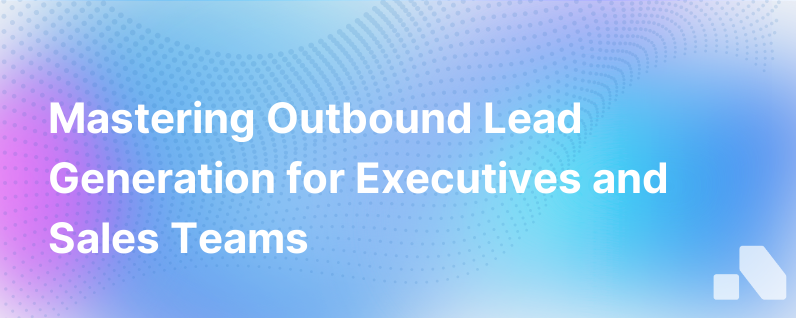
In the fast-paced world of B2B sales, the outbound lead generation process remains a cornerstone of a successful revenue strategy. Beyond the reach of SEO and the grasp of inbound tactics, a strong outbound lead generation framework is the engine driving growth in uncharted territories. It's the initiative taken to foster connections with potential customers who have not yet expressed direct interest in your offerings.
Let’s shift through the layers of outbound lead generation, peel back its intricacies, and decode its methodology. This article provides a detailed walkthrough of what an outbound lead generation process involves, its pivotal role in your sales playbook, and strategies that you can employ to optimize this process.
Understanding Outbound Lead Generation
Outbound Lead Generation is the proactive approach to targeting and engaging potential customers. It's the art of initiating a conversation and building relationships through a variety of channels including cold calls, emails, social outreach, and direct mail. Traditional yet dynamic, its agility is reflected in how it adapts to the ever-evolving landscape of business communications.
The Role and Importance of an Outbound Lead Generation Strategy
In contrast to inbound methods which rely on prospects finding you, outbound lead generation puts you in the driver's seat. It enables you to strategically target prospects based on predefined criteria such as industry, company size, and role. This granular level of targeting translates to conversations with high-potential leads and yields a richer pipeline.
For startups and established enterprises alike, it fuels the momentum for market penetration and customer acquisition. Outbound strategies propel you into the spotlight, fostering brand awareness in sectors where your presence might otherwise go unnoticed.
Components of the Outbound Lead Generation Process
An effective outbound lead generation process can be broken down into a series of meticulous steps:
1. Target Market Identification
A clear understanding of your target market is the launching pad of outbound lead generation. Define who needs your solution. Build a profile of your ideal customer persona: their pain points, industry norms, and decision-makers.
2. Data Collection and Prospect List Building
Empowered by your customer persona, compile a prospect list. This involves collecting contact and firmographic information from various sources. Consider the use of automated prospecting tools, databases or purchasing lists from reputable vendors to streamline this stage.
3. Crafting Outbound Communication
With your targets identified, it's time to reach out. The crafting of your message is pivotal. Tailor your communications for resonance and relevance. Each email, call script, or social message should convey value and pique the interest of potentially cold prospects.
4. Outreach Execution
Launch your outreach efforts across the channels your prospects are known to inhabit. Leverage the power of cold emails paired with follow-up calls, engage in social selling on platforms like LinkedIn, and experiment with direct mail for unique touchpoints.
5. Follow-Up and Engagement
Persistence is key. Implement a structured follow-up strategy, tactfully nudging prospects through multiple touchpoints. The goal is to open dialogue and prompt a warm conversation. Monitor responses and adapt your approach accordingly.
6. Qualification and Lead Nurturing
Not every prospect will be ready to buy. Qualify responses using a clear set of criteria such as BANT (Budget, Authority, Need, and Timing). For those not yet ready, establish a nurturing campaign to maintain interest and build credibility over time.
7. Conversion into Sales Opportunities
Qualified leads should be handed over to the sales team for the next phase in the buyer's journey. A seamless transition from marketing to sales is crucial. Ensure that all the rich data gathered is available to the sales team to continue the dialogue.
Optimizing Your Outbound Lead Generation Process
For an outbound approach to be successful, each stage must be optimized for efficiency and impact. Here are strategies to enhance your process:
-
Use Automation and AI Technology: Implement smart tools to automate repetitive tasks within the lead gen process. Consider adopting advanced systems like Aomni for heightened intelligence and deeper insights.
-
Personalize at Scale: With automation technology, achieve a balance between scale and personalization. Craft messages that feel individually tailored, even when sent to large groups.
-
Continual Testing and Refinement: Employ A/B testing for your outreach messages and calls to action. This iterative approach allows you to continually refine your strategy for maximal results.
-
Sales and Marketing Alignment: Foster a culture where sales and marketing teams work in lockstep. Unified goals and clear communication pathways ensure strategic harmony and collective success.
-
Analytics and Performance Monitoring: Implement detailed tracking and analytics to monitor the performance of various channels and messages. This data will guide your strategic decisions.
-
Training and Development: Equip your team with the necessary skills. Invest in training that enhances communication, negotiation, and analytics prowess to enrich every interaction with potential leads.
In Conclusion
The outbound lead generation process is a complex symphony involving multiple instruments - each requiring adept handling. A structured, optimized process is not just a benefit; it's a necessity for any organization intent on scaling its growth and cementing its market position. Tools like Aomni can offer critical leverage in elevating your outbound strategy, but it’s the harmonious blend of technology, human talent, and strategic foresight that will ultimately resonate with your target audience and drive your sales success.